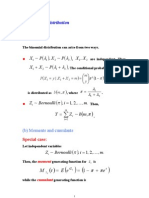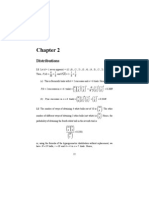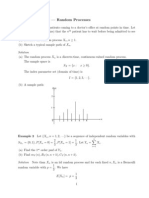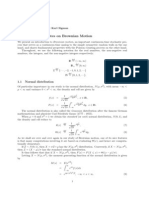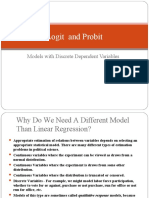Y e y Y P: (A) Poisson Distribution and Poisson Process
Uploaded by
juntujuntuY e y Y P: (A) Poisson Distribution and Poisson Process
Uploaded by
juntujuntu1
4.2 Likelihood Functions
(a) Poisson distribution and Poisson process
Poisson distribution:
The distribution of a Poisson random variable Y is
( )
! y
e
y Y P
y
= =
.
The cumulant generating function is
( ) ( ) 1 =
t
Y
e t k
.
Thus,
( )
( )
| | = =
(
=
=
=
0
0
t
t
t
Y
e
t
t k
Y E
and
( )
( )
| | = =
(
=
=
=
0
0
2
2
t
t
t
Y
e
t
t k
Y Var
.
Important Result:
Any random variable X whose cumulants are
( ) n O
, where n is
some quantity tending to infinity, has the limiting property
( )
( )
|
.
|
\
|
+
=
2
1
2
1
2
1 , 0 ~ n O N
X Var
X
k
X
p
,
2
where
( ) X E =
. In particular, for the Poisson random variable Y,
as
( ) = Y Var
,
( )
|
.
|
\
|
+
2
1
2
1
1 , 0 ~ n O N
Y
p
Important Properties:
For large
, the variance-stabilizing transform is
2
1
Y in the sense
that
4
1
,
2
1
2
1
2
1
|
.
|
\
|
|
.
|
\
|
Y Var Y E
.
The other transformation which approximates standard Normal is
( )
( )
= +
+
=
0 ,
6
2
0 ,
6
3 3
2
1
2
1
2
1
3
1
6
1
2
1
Y
Y Y Y
Y g
Poisson process:
There are 3 equivalent definitions for Poisson process. They are:
Definition 1:
Suppose events are occurring successively in time, with the intervals
between successive events independently and identically
distributed according to an exponential density
3
( )
t
e t f
=
.
Denote the number of events during
| | t , 0
by
( ) t N
. Then, the
stochastic process
( ) { } 0 ; t t N
is called a Poisson process with
mean rate (or intensity)
.
Definition 2:
An integer valued process
( ) { } 0 ; t t N
is a Poisson process with
mean rate
if
(a)
( ) { } 0 ; t t N
has stationary independent increments.
(b) For time points s and t,
t s <
, the number
( ) ( ) s N t N
of
counts in the interval
| | t s ,
has a Poisson distribution with mean
( ) s t
:
( ) ( ) ( )
( )
( ) | |
! k
s t e
k s N t N P
k
s t
= =
Definition 3:
As in Definition 1, let
( ) t N
denote the number of events that have
occurred during
| | t , 0
. Suppose that whatever the number of events
during
| | t , 0
,
(a) the probability of an event during
| | h t t + ,
is
( ) h o h +
.
(b) the probability of more than one event during
| | h t t + ,
is
4
( ) h o
.
Then, the stochastic process
( ) { } 0 ; t t N
is called a Poisson
process with mean rate
.
(b) The Poisson log-likelihood function
The Poisson log-likelihood function for
n
Y Y Y , , ,
2 1
K
is
( ) ( ) ( )
=
n
i
i i i n
y l
1
2 1
log , , , K
,
where
( )
i i
Y E =
. The deviance function is
( ) ( ) ( )
( )
( )
= =
=
(
(
|
|
.
|
\
|
=
(
(
|
|
.
|
\
|
=
=
n
i
i i
n
i
i
i
i
n
i
i i
i
i
i
n n n n
y
y
y
y
y
y
y y l y y D
1 1
1
1 1 1 1
2
log 2
log 2
, , 2 , , 2 , , , , ,
K K K K
where
i
is the estimate of
( )
i i
Y E =
Note:
If a constant term is included in the model, it can be shown that
( ) 0
1
=
=
n
i
i i
y
.
Thus, the deviance function can be reduced to
5
( )
= (
(
|
|
.
|
\
|
=
n
i
i
i
i n n
y
y y y D
1
1 1
log 2 , , , , ,
K K
.
Note:
The deviance function is closely related to Pearsons statistic. Since
( )
i i i i
i
i
i
i
i i
y
y y
+ = + = =
1 1
,
then
( ) ( ) ( )
( ) ( ) | |
( )
2
2
2 2
2
1
1 log 1
1 log 1
log
2
2
3
2
2
2
i i
i
i
i
i
i
i
i i
i
i
i i i
i i i i
i i i i i i i
i
i
i
y
y
y
|
|
.
|
\
|
+ =
(
|
|
.
|
\
|
+ + =
(
|
|
.
|
\
|
+ + =
+ + =
+ + =
|
|
.
|
\
|
L
L
L
where
( ) L + = +
2
1 log
2
i
i i
. Thus,
6
( ) ( )
( )
statistic s Pearson'
log 2 , , , , ,
1
2
1
1 1
(
(
|
|
.
|
\
|
=
=
=
n
i
i
i i
n
i
i i
i
i
i n n
y
y
y
y y y D
K K
You might also like
- Quality Control and Standard Operating Procedures100% (1)Quality Control and Standard Operating Procedures23 pages
- 3.3 The Multinomial Distribution: (A) SourceNo ratings yet3.3 The Multinomial Distribution: (A) Source6 pages
- (A) Modeling: 2.3 Models For Binary ResponsesNo ratings yet(A) Modeling: 2.3 Models For Binary Responses6 pages
- MATH 437/ MATH 535: Applied Stochastic Processes/ Advanced Applied Stochastic ProcessesNo ratings yetMATH 437/ MATH 535: Applied Stochastic Processes/ Advanced Applied Stochastic Processes7 pages
- International Journal of Mathematics and Statistics Invention (IJMSI)No ratings yetInternational Journal of Mathematics and Statistics Invention (IJMSI)7 pages
- Paper 23-A New Type Method For The Structured Variational Inequalities ProblemNo ratings yetPaper 23-A New Type Method For The Structured Variational Inequalities Problem4 pages
- (A) Model Assumptions: 1.2 Outline of Generalized Linear ModelsNo ratings yet(A) Model Assumptions: 1.2 Outline of Generalized Linear Models8 pages
- 1.5 Measuring The Goodness of Fit: Special CaseNo ratings yet1.5 Measuring The Goodness of Fit: Special Case6 pages
- (3x) (1+ 1 3x) 1 2 3x + 1 2 (1 2 1) 2 (1 3x) + ...... ) (3x) + 1 2 (3x) 1 8 (3x) + ......No ratings yet(3x) (1+ 1 3x) 1 2 3x + 1 2 (1 2 1) 2 (1 3x) + ...... ) (3x) + 1 2 (3x) 1 8 (3x) + ......10 pages
- Normed Linear Spaces Notes by DR E - Prempeh - GhanaNo ratings yetNormed Linear Spaces Notes by DR E - Prempeh - Ghana13 pages
- Problems by Jim Pitman. Solutions by George ChenNo ratings yetProblems by Jim Pitman. Solutions by George Chen8 pages
- Slides - Complete Variance Decomposition MethodsNo ratings yetSlides - Complete Variance Decomposition Methods21 pages
- The Expected Number of Real Zeros of Random Polynomial: American Journal of Engineering Research (AJER)No ratings yetThe Expected Number of Real Zeros of Random Polynomial: American Journal of Engineering Research (AJER)11 pages
- Discrete Random Variables and Probability DistributionsNo ratings yetDiscrete Random Variables and Probability Distributions36 pages
- Solutions Advanced Econometrics 1 Midterm 2013No ratings yetSolutions Advanced Econometrics 1 Midterm 20133 pages
- Detailed Solutions A-07 JUNE 2003: I X X F F INo ratings yetDetailed Solutions A-07 JUNE 2003: I X X F F I32 pages
- Sampling and Quantization Theory For Image Processing: IraldiNo ratings yetSampling and Quantization Theory For Image Processing: Iraldi5 pages
- Exp: L L: 4.4 Comparison of Two or More Poisson MeansNo ratings yetExp: L L: 4.4 Comparison of Two or More Poisson Means8 pages
- I. Newton-Raphson Method - 2 Dim Case: X X X X FNo ratings yetI. Newton-Raphson Method - 2 Dim Case: X X X X F9 pages
- Random Process in Analog Communication Systems100% (1)Random Process in Analog Communication Systems91 pages
- Constant Strain Triangle (CST) : BY R.PONNUSAMY (2008528)No ratings yetConstant Strain Triangle (CST) : BY R.PONNUSAMY (2008528)33 pages
- Function and General Class of Polynomial and Heat Conduction in A RodNo ratings yetFunction and General Class of Polynomial and Heat Conduction in A Rod5 pages
- Some Applications Involving Binary Data: (A) Comparison of Two Binomial ProbabilitiesNo ratings yetSome Applications Involving Binary Data: (A) Comparison of Two Binomial Probabilities7 pages
- 1 IEOR 4700: Notes On Brownian Motion: 1.1 Normal DistributionNo ratings yet1 IEOR 4700: Notes On Brownian Motion: 1.1 Normal Distribution11 pages
- A New Non-Symmetric Information Divergence ofNo ratings yetA New Non-Symmetric Information Divergence of7 pages
- Student's Solutions Manual and Supplementary Materials for Econometric Analysis of Cross Section and Panel Data, second editionFrom EverandStudent's Solutions Manual and Supplementary Materials for Econometric Analysis of Cross Section and Panel Data, second editionNo ratings yet
- Student Solutions Manual to Accompany Economic Dynamics in Discrete Time, secondeditionFrom EverandStudent Solutions Manual to Accompany Economic Dynamics in Discrete Time, secondedition4.5/5 (2)
- Digital Signal and Image Processing using MATLAB, Volume 3: Advances and Applications, The Stochastic CaseFrom EverandDigital Signal and Image Processing using MATLAB, Volume 3: Advances and Applications, The Stochastic Case3/5 (1)
- An Introduction To Scalar Kalman Filters PDFNo ratings yetAn Introduction To Scalar Kalman Filters PDF10 pages
- 3 Transformations in Regression: Y X Y XNo ratings yet3 Transformations in Regression: Y X Y X13 pages
- 5 One-Way ANOVA (Review) and Experimental DesignNo ratings yet5 One-Way ANOVA (Review) and Experimental Design15 pages
- 9 Review of Discrete Data Analysis: Comparing Two Proportions: Independent SamplesNo ratings yet9 Review of Discrete Data Analysis: Comparing Two Proportions: Independent Samples18 pages
- Rayleigh Probability Distribution Applied To Random Wave HeightsNo ratings yetRayleigh Probability Distribution Applied To Random Wave Heights3 pages
- Logit and Probit: Models With Discrete Dependent VariablesNo ratings yetLogit and Probit: Models With Discrete Dependent Variables30 pages
- Tbi.b - (1) Research Assumption and Hypotheses100% (2)Tbi.b - (1) Research Assumption and Hypotheses5 pages
- Calculus 1: 2H-Derivatives of Elementary Transcendental FunctionsNo ratings yetCalculus 1: 2H-Derivatives of Elementary Transcendental Functions39 pages
- Introduction To Finite Element Method PDFNo ratings yetIntroduction To Finite Element Method PDF13 pages
- Applied Chem. 9, 1ST Summative Test 04.11.2023No ratings yetApplied Chem. 9, 1ST Summative Test 04.11.20234 pages
- MG6851-Principles of Management QUESTION BANKNo ratings yetMG6851-Principles of Management QUESTION BANK10 pages
- Table of Integrals: Products of Trigonometric Functions and Monomials Integrals of Inverse Trigonometric FunctionsNo ratings yetTable of Integrals: Products of Trigonometric Functions and Monomials Integrals of Inverse Trigonometric Functions2 pages
- Expert Professional Academy Pvt. Ltd. - Ca-Foundation: DD-271 by Ca Vinod ReddyNo ratings yetExpert Professional Academy Pvt. Ltd. - Ca-Foundation: DD-271 by Ca Vinod Reddy3 pages
- (Ebook) Practical multivariate analysis by Abdelmonem Afifi, Virginia A Clark, Robin A Donatello, Susanne May ISBN 9781351788908, 9781351788915, 1351788906, 1351788914 download pdf100% (5)(Ebook) Practical multivariate analysis by Abdelmonem Afifi, Virginia A Clark, Robin A Donatello, Susanne May ISBN 9781351788908, 9781351788915, 1351788906, 1351788914 download pdf67 pages
- General Mathematics 11: Department of Education Region Iv - A Calabarzon Division of Laguna District of BayNo ratings yetGeneral Mathematics 11: Department of Education Region Iv - A Calabarzon Division of Laguna District of Bay3 pages
- Control Systems (CS) : Lecture-17 Routh-Herwitz Stability CriterionNo ratings yetControl Systems (CS) : Lecture-17 Routh-Herwitz Stability Criterion30 pages
- Multiple-Choice Test Shooting Method: X X DX y DNo ratings yetMultiple-Choice Test Shooting Method: X X DX y D4 pages
- Profit Functions: Epresentation of EchnologyNo ratings yetProfit Functions: Epresentation of Echnology34 pages
- MATH 437/ MATH 535: Applied Stochastic Processes/ Advanced Applied Stochastic ProcessesMATH 437/ MATH 535: Applied Stochastic Processes/ Advanced Applied Stochastic Processes
- International Journal of Mathematics and Statistics Invention (IJMSI)International Journal of Mathematics and Statistics Invention (IJMSI)
- Paper 23-A New Type Method For The Structured Variational Inequalities ProblemPaper 23-A New Type Method For The Structured Variational Inequalities Problem
- (A) Model Assumptions: 1.2 Outline of Generalized Linear Models(A) Model Assumptions: 1.2 Outline of Generalized Linear Models
- (3x) (1+ 1 3x) 1 2 3x + 1 2 (1 2 1) 2 (1 3x) + ...... ) (3x) + 1 2 (3x) 1 8 (3x) + ......(3x) (1+ 1 3x) 1 2 3x + 1 2 (1 2 1) 2 (1 3x) + ...... ) (3x) + 1 2 (3x) 1 8 (3x) + ......
- Normed Linear Spaces Notes by DR E - Prempeh - GhanaNormed Linear Spaces Notes by DR E - Prempeh - Ghana
- The Expected Number of Real Zeros of Random Polynomial: American Journal of Engineering Research (AJER)The Expected Number of Real Zeros of Random Polynomial: American Journal of Engineering Research (AJER)
- Discrete Random Variables and Probability DistributionsDiscrete Random Variables and Probability Distributions
- Sampling and Quantization Theory For Image Processing: IraldiSampling and Quantization Theory For Image Processing: Iraldi
- Exp: L L: 4.4 Comparison of Two or More Poisson MeansExp: L L: 4.4 Comparison of Two or More Poisson Means
- Constant Strain Triangle (CST) : BY R.PONNUSAMY (2008528)Constant Strain Triangle (CST) : BY R.PONNUSAMY (2008528)
- Function and General Class of Polynomial and Heat Conduction in A RodFunction and General Class of Polynomial and Heat Conduction in A Rod
- Some Applications Involving Binary Data: (A) Comparison of Two Binomial ProbabilitiesSome Applications Involving Binary Data: (A) Comparison of Two Binomial Probabilities
- 1 IEOR 4700: Notes On Brownian Motion: 1.1 Normal Distribution1 IEOR 4700: Notes On Brownian Motion: 1.1 Normal Distribution
- Student's Solutions Manual and Supplementary Materials for Econometric Analysis of Cross Section and Panel Data, second editionFrom EverandStudent's Solutions Manual and Supplementary Materials for Econometric Analysis of Cross Section and Panel Data, second edition
- Student Solutions Manual to Accompany Economic Dynamics in Discrete Time, secondeditionFrom EverandStudent Solutions Manual to Accompany Economic Dynamics in Discrete Time, secondedition
- Digital Signal and Image Processing using MATLAB, Volume 3: Advances and Applications, The Stochastic CaseFrom EverandDigital Signal and Image Processing using MATLAB, Volume 3: Advances and Applications, The Stochastic Case
- 9 Review of Discrete Data Analysis: Comparing Two Proportions: Independent Samples9 Review of Discrete Data Analysis: Comparing Two Proportions: Independent Samples
- Rayleigh Probability Distribution Applied To Random Wave HeightsRayleigh Probability Distribution Applied To Random Wave Heights
- Logit and Probit: Models With Discrete Dependent VariablesLogit and Probit: Models With Discrete Dependent Variables
- Calculus 1: 2H-Derivatives of Elementary Transcendental FunctionsCalculus 1: 2H-Derivatives of Elementary Transcendental Functions
- Table of Integrals: Products of Trigonometric Functions and Monomials Integrals of Inverse Trigonometric FunctionsTable of Integrals: Products of Trigonometric Functions and Monomials Integrals of Inverse Trigonometric Functions
- Expert Professional Academy Pvt. Ltd. - Ca-Foundation: DD-271 by Ca Vinod ReddyExpert Professional Academy Pvt. Ltd. - Ca-Foundation: DD-271 by Ca Vinod Reddy
- (Ebook) Practical multivariate analysis by Abdelmonem Afifi, Virginia A Clark, Robin A Donatello, Susanne May ISBN 9781351788908, 9781351788915, 1351788906, 1351788914 download pdf(Ebook) Practical multivariate analysis by Abdelmonem Afifi, Virginia A Clark, Robin A Donatello, Susanne May ISBN 9781351788908, 9781351788915, 1351788906, 1351788914 download pdf
- General Mathematics 11: Department of Education Region Iv - A Calabarzon Division of Laguna District of BayGeneral Mathematics 11: Department of Education Region Iv - A Calabarzon Division of Laguna District of Bay
- Control Systems (CS) : Lecture-17 Routh-Herwitz Stability CriterionControl Systems (CS) : Lecture-17 Routh-Herwitz Stability Criterion



